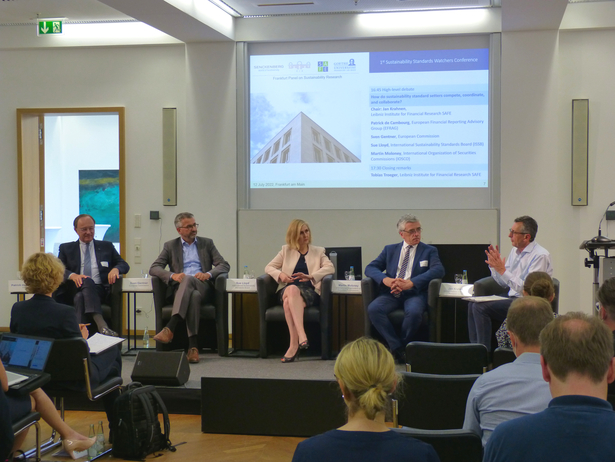
Frankfurt Panel on Sustainability Research
The Frankfurt Panel on Sustainability Research is a group of scientists from three Leibniz institutes – the Senckenberg Biodiversity and Climate Research Center, the Potsdam Institute for Climate Impact Research and the Leibniz Institute for Financial Research SAFE – and the Goethe University Frankfurt. The core mission of the Frankfurt Panel on Sustainability Research (FPSR) is to provide a neutral platform for a science-based critical assessment and evaluation of sustainability standards.
The Sustainability Standards Watchers Conference
One of the main purposes of the conference is to shed light on the process of sustainability standard setting. The timing of the conference is not coincidental, but intentionally scheduled after the consultation period of the ISSB prototypes.
The FPSR’s first hybrid conference proposed a dialogue among biodiversity, climate, economic and legal scholars, on the one hand, and financial industry, policy makers, central banks and the International Sustainability Standards Board (ISSB), on the other.
The three interdisciplinary panel discussions centered around four questions that address the impact of ecological standards for corporations and capital providers. The speakers focused on the purpose of and the conditions for effective international ecological standard setting in today’s societies, economies and the Earth’s system.
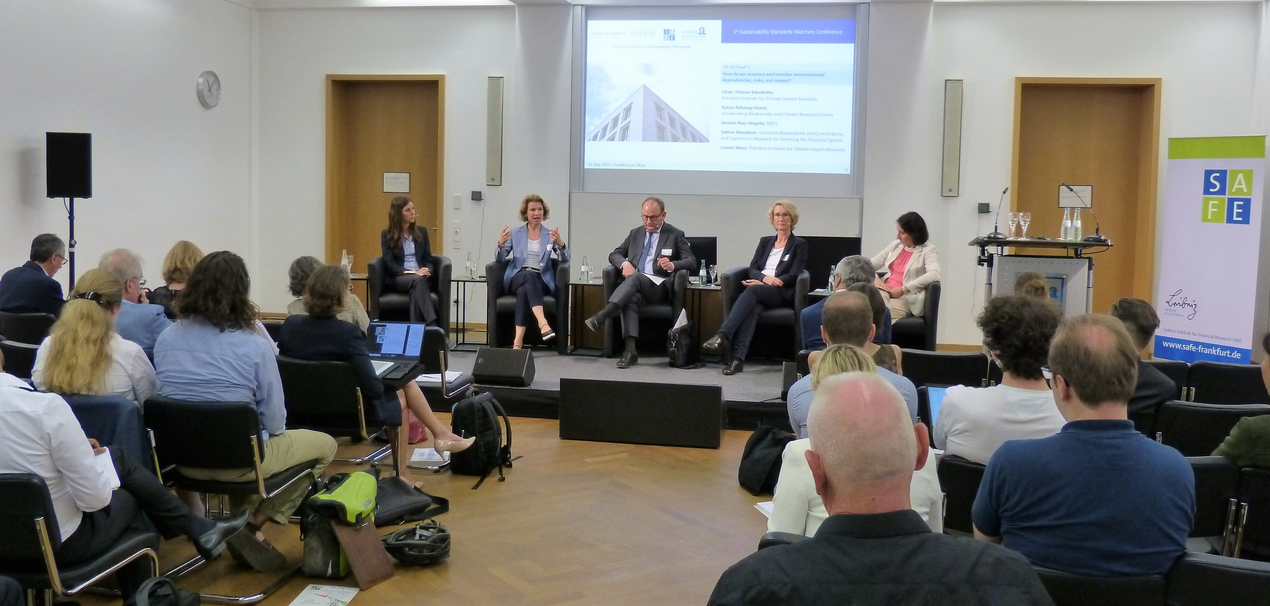
The discussions in brief
- Panel 1 | How do we measure and monitor environmental dependencies, risks, and impact?
The social cost of carbon helps to quantify impacts of climate change
Chaired and moderated by Ottmar Edenhofer of the Potsdam Institute for Climate Impact Research (PIK), Katrin Böhning-Gaese (Senckenberg Biodiversity and Climate Research Center), Simone Ruiz-Vergote (MSCI ESG Research), Sabine Mauderer (Deutsche Bundesbank and Central Banks and Supervisors Network for Greening the Financial System), and Leonie Wenz (PIK) discussed the social cost of carbon, which is at the heart of measuring and monitoring climate-related dependencies, risks, and impacts. Acute and chronic changes in climate ultimately impose costs on society, such as health impacts or reduced productivity. This is what the participants of the first panel of the Sustainability Standards Watchers Conference 2022 agreed upon.
Leonie Wenz explained: “The social cost of carbon actually is an accounting exercise to quantify climate impacts across time and space and to convert them into a common unit like US dollars through valuation and discounting.” The climate change expert from the research department Complexity science at PIK emphasized that while quantifying such costs is challenging, this exercise is essential for a proper assessment of climate change impacts and corresponding policy initiatives.
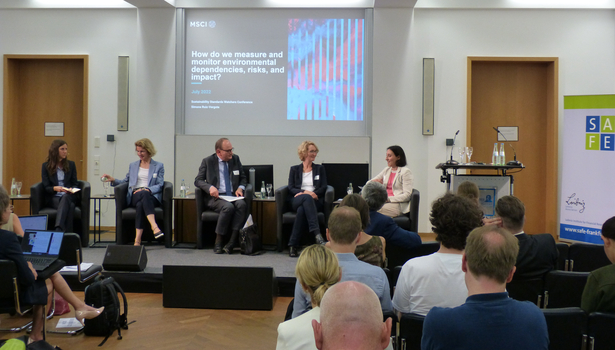
Measuring and monitoring nature-related dependencies, risks and impacts may be even more complicated, according to Katrin Böhning-Gaese, a professor at Goethe University Frankfurt and director of the Senckenberg Biodiversity and Climate Research Centre. Biodiversity loss also imposes costs on society. The complex impacts, however, would make it difficult to find a single measurement approach.
In addition, Sabine Mauderer pointed out that both climate- and nature-related risks may materialize in financial risks: “Prices will be and are affected by climate change,“ the member of the executive board of the Deutsche Bundesbank said. According toBundesbank, there are two significant risks for financial stability, she said: the physical risk, such as weather events, floods, hurricanes, and the transitional risk that occurs if policy makers do too little too late.
Simone Ruiz-Vergote, the global head of ESG and climate policy at the US financial services provider MSCI, mentioned that investors lack sufficient information to measure and monitor such dependencies, risks, and impacts. “For example, they lack location information about companies’ supply chains”, Ruiz-Vergote said. However, this information may be relevant for their financial decisions and may also be useful for example, for customers, as highlighted by Katrin Böhning-Gaese. Sabine Mauderer concluded that one example of a useful disclosure by companies could be transition plans. Companies would be forced to acknowledge and assess financial risks due to environmental dependencies and impacts. Investors, in turn, could use this information to assess the extent to which companies acknowledge these risks and price risks in.
- Panel 2 | How do investors react to climate risks? What do and what should they care about?
Investors finance green transition and can perform better when aware of climate risks
Chaired and moderated by Tobias Tröger, Director of SAFE’s “Law & Finance” Cluster, Almut Arneth (Karlsruhe Institute of Technology), Jeffrey Gordon (Columbia University), Lucrezia Reichlin (London Business School and International Financial Reporting Standards Foundation), and Maximilian Horster (Head of ISS ESG at Institutional Shareholder Services Inc.) discussed what measures investors need so that the systemic risk of climate change can be dealt with.
According to Jeffrey Gordon, investors can better price systemic risks in when they are aware of possible climate risks. Disclosure processes would need to have a multiplier effect to manage these risks. Following Gordon’s argument, Lucrezia Reichlin mentioned that investors are only one part of the story. They finance the transition towards green but it needs different tools to combat climate change as each tool comes with limitations, for instance, a carbon tax.
Climate change needs to be recognized as a complex system change and targeted achievements can only be measured through holistic information, Almut Arneth explained. To shed light on the question from a data perspective, Maximilian Horster emphasized that investors have two main perspectives when considering the effect of climate change in their investments: their impact and risk considerations, with both parts influencing each other.
During the open discussion, the panelists argued in favor of standardized information from companies. However, they regard ESG ratings as questionable, since these ratings, unlike credit ratings, only look at defaults that make their interpretation difficult.
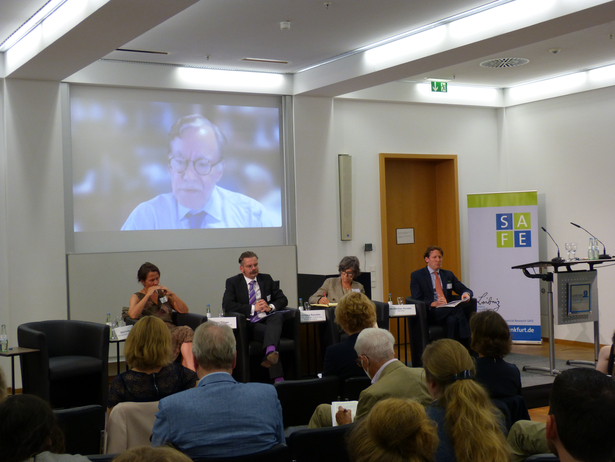
- Keynote speech | Dissecting Green Returns
How increased climate concerns account for high returns in green assets
Robert F. Stambaugh presented a joint paper with Lubos Pastor and Lucian A. Taylor in the keynote speech on Dissecting Green Returns. Surveyed investors and asset managers often suggest a superior future performance of green stocks relative to brown stocks. But past performance may not be indicative of future performance, the finance professor from the Wharton School of the University of Pennsylvania stated: “We say, sustainable assets have lower expected returns.”
The authors propose that green stocks only have higher realized returns (i.e., ex post), not higher expected returns (i.e., ex ante). This might be to the non-monetary preferences of sustainability-oriented investors. This increased utility for investors from holding these stocks may enable a lower cost of capital for green firms, Stambaugh said at the conference.
Green stocks could be better hedge against climate risk. Furthermore, realized returns could be higher for green stocks due to new strong climate concerns, Stambaugh continued. For instance, the demand of investors for green assets or the demand of consumers for green products may have unexpectedly shifted over time. This may change the ex-post performance of green stocks.
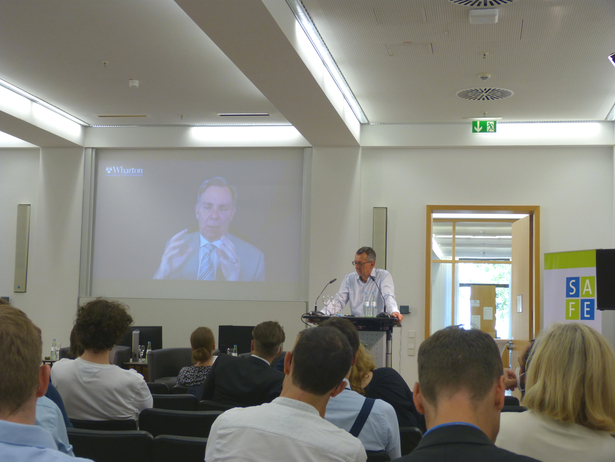
Stambaugh and his co-authors looked at German twin bonds and the greenness of US firm stocks based on MSCI ESG Ratings. In 2020, the German government issued two identical sovereign bonds that differed only in the extent to which they were used for “green” expenditures. As observed, the green bond mostly sold at a higher yield than the brown bond. Similarly, green US firm stocks had lower expected returns than brown US firm stocks in the 2010s, whereas green stocks had higher realized returns than brown stocks during the sample period. “This difference in performance can be explained by new strong climate concerns by investors and consumers”, Stambaugh concluded.
- Panel 3 | How do sustainability standards affect decisions of firms?
Levels of information and data shape company behavior
Chaired and moderated by Loriana Pelizzon, Director of SAFE’s Research Department Financial Markets, Marcin Kacperczyk (Imperial College London), Enrico Moretti Polegato (President of Diadora), and Irene Monasterolo (EDHEC) approached the topic at hand from a different perspective: While the conference had previously focused on exploring sustainability standards from an investors’ point of view, the panel set out to assess how such standards affect the decisions of firms.
Kicking off the debate, EDHEC Business School affiliate Irene Monasterolo reflected on her multiple-year experience with climate financial risk disclosure as well as climate risk assessment and claimed that it is crucial to introduce climate into financial risk assessments for corporate actors. To expand on her position, Monasterolo illustrated how financial risk assessment regarding climate can be put into practice, and showcased factors that still impede effective climate stress testing and climate risk disclosures.
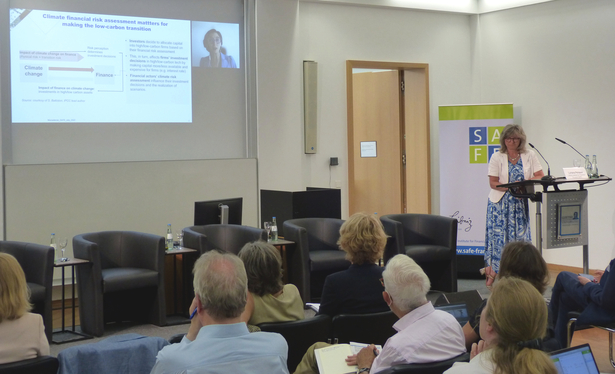
Finance professor Marcin Kacperczyk from the Imperial College London agreed that climate risk disclosures are important to stay informed about whether companies proceed on their designated decarbonization pathway. “When companies commit, they commit not only to the scope of emissions reduced but also commit to the time horizon of how to do it,” Kacperczyk said. However, often stakeholders or peer pressure would mandate to do so - not the company´s initiative.
Speaking as an actual corporate representative, Enrico Moretti Polegato, who is president of the Italian sportswear and footwear manufacturing company Diadora, finally weighed in on the costs that sustainable economic practices and corresponding reporting requirements impose on firms.
In summary, Loriana Pelizzon clarified that regulatory changes were coming quickly – but financial research is responding. An urgent research question is to what extent operational performance and corporate investment decisions are influenced by exposure to adverse biodiversity impact and whether investors care about biodiversity risk exposures at all. However, each question starts from the premise: “Measurement is key,” Pelizzon said.
- High-level debate | How do sustainability standard setters compete, coordinate, and collaborate?
Climate change forces a rush to sustainability standards
Currently, competing institutions must coordinate and cooperate in setting sustainability standards. Much like climate change is leading to previously unobserved phenomena, gathering, documenting, and reporting information for binding sustainability standards is an emerging discipline, as Patrick de Cambourg pointed out during the high-level debate moderated by SAFE Director Jan Pieter Krahnen. Cambourg, representing the European Financial Reporting Advisory Group (EFRAG), which provides technical expertise to the EU Commission in the process of adopting International Financial Reporting Standards (IFRS), shared the panel with Sven Gentner of the EU Commission, Sue Lloyd of the International Sustainability Standards Board (ISSB), and Martin Moloney, Secretary General of the International Organization of Securities Commissions (IOSCO).
